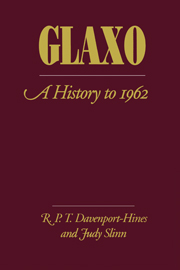Book contents
- Frontmatter
- Contents
- List of illustrations
- List of tables
- Acknowledgements
- Introduction
- Part I Merchants and bonnie babies
- 1 The origins – Joseph Nathan & Co
- 2 The Nathans and proprietary foods 1903–1918
- 3 Boom and depression for Glaxo and the Nathans
- 4 Diversification into pharmaceuticals: Glaxo Laboratories Ltd
- 5 Early internationalisation and the growth of overseas markets 1909–1939
- Part II Pharmaceuticals in Britain
- Part III Internationalisation of pharmaceuticals
- Appendix: Glaxo statistics
- Notes
- Select bibliography
- Index
3 - Boom and depression for Glaxo and the Nathans
Published online by Cambridge University Press: 05 March 2012
- Frontmatter
- Contents
- List of illustrations
- List of tables
- Acknowledgements
- Introduction
- Part I Merchants and bonnie babies
- 1 The origins – Joseph Nathan & Co
- 2 The Nathans and proprietary foods 1903–1918
- 3 Boom and depression for Glaxo and the Nathans
- 4 Diversification into pharmaceuticals: Glaxo Laboratories Ltd
- 5 Early internationalisation and the growth of overseas markets 1909–1939
- Part II Pharmaceuticals in Britain
- Part III Internationalisation of pharmaceuticals
- Appendix: Glaxo statistics
- Notes
- Select bibliography
- Index
Summary
Glaxo in the immediate post-war years
The rapid expansion of the Glaxo business during the first World War continued into 1919. After the Ministry of Food had relinquished its control of dried milk in April of that year, the Glaxo Department resumed direct trading with municipalities and in 1920–1921, turnover with them alone was £495,000. The end of the war presented an opportunity to recruit new staff, much needed by the business. Colonel E. A. Rose was a graduate engineer, trained and experienced, who gradually assumed responsibility for manufacturing operations. Archibald Sandercock, a Chief Inspector of Gunnery with the Royal Artillery during the First World War, was recruited as a director in 1919. On the marketing side, Hugo Wolff had assisted Alec Nathan during the war-time expansion and in 1919 he was appointed sales manager.
Alec himself was much exercised at that time by the problem of quality control of the supplies of dried milk sent from New Zealand. He warned the Wellington office in 1919 that although seven or eight years previously the Glaxo powder which they supplied was ‘pre-eminent in quality’, the distinction ‘has largely been bridged by the added experience of other manufacturers and the lowering of the standard of quality of the N.Z. Glaxo’. There were not enough skilled and experienced operatives to cope with the swift expansion of the Nathan milk drying operations in New Zealand.
- Type
- Chapter
- Information
- GlaxoA History to 1962, pp. 46 - 67Publisher: Cambridge University PressPrint publication year: 1992



